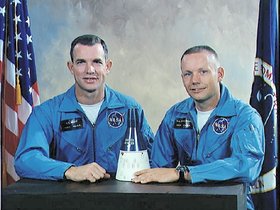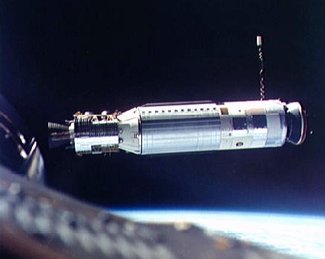Gemini 8
|
|
| Mission Insignia | |
|---|---|

| |
| Mission Statistics | |
| Mission Name: | Gemini 8 |
| Call Sign: | Gemini 8 |
| Number of Crew: | 2 |
| Launch: | March 16, 1966 16:41:02.389 UTC Cape Canaveral LC 19 |
| Agena Docking: Docked: Undocked: | March 16, 1966 22:14 UTC ~22:45 UTC |
| Landing: | March 17, 1966 03:22:28 UTC Template:Coor dm |
| Duration: | 10 hours 41 minutes 26 seconds |
| Distance Traveled: | ~293,206 km |
| Orbits: | 6.75 |
| Apogee: (1st orbit) | 271.9 km |
| Perigee: (1st orbit) | 159.9 km |
| Period: (1st orbit) | 88.83 m |
| Inclination: | 28.91 deg |
| Mass: | 3,789 kg |
| Crew Picture | |
 Gemini 8 crew portrait (L-R: Scott, Armstrong) | |
| Gemini 8 Crew | |
Gemini 8 (officially Gemini VIII) was a 1966 manned spaceflight in NASA's Gemini program. It was the 6th manned Gemini flight, the 12th manned American flight and the 22nd spaceflight of all time (includes X-15 flights over 100 km).
| Contents |
Crew
- Neil Armstrong (flew on Gemini 8 & Apollo 11), Command Pilot
- David Scott (flew on Gemini 8, Apollo 9, & Apollo 15), Pilot
Backup Crew
- Charles Conrad, Jr., Command Pilot
- Richard F. Gordon, Jr., Pilot
Mission Parameters
- Mass: 3,789 kg
- Perigee: 159.9 km
- Apogee: 271.9 km
- Inclination: 28.91°
- Period: 88.83 min
See also
Objectives
Gemini VIII had two major objectives, of which it achieved one. The two objectives were:
1. to accomplish an in-orbit rendezvous and docking, and
2. to accomplish an extended Extra-vehicular Activity. Edward White of Gemini IV had spent a short 20 minutes outside of the spacecraft.
The first major objective was accomplished by the spacecraft commander, Neil Armstrong, who piloted Gemini VIII to within 0.9 meters of the prelaunched Agena Target Vehicle, then slowly docked. This was the first orbital docking ever. The second objective was to have been accomplished by Pilot David Scott, who was to spend up to two hours outside of the spacecraft, but subsequent events cancelled the planned space-walk.
What followed the successful docking by Armstrong were some of the most hair-raising few minutes in space-program history. The Gemini VIII capsule, still docked to the Agena, began rolling continuously. Never having faced this in simulation, the crew undocked from the Agena, but the problem was a stuck thruster on the spacecraft, which now tumbled even faster, at the dizzying rate of one revolution per second. The only way to stop the motion was to use the capsule's reentry control thrusters, which meant that Armstrong and Scott had to cut short their mission and make an emergency return to Earth 10 hours after launch. They were still nauseated after splashdown, as well as disappointed: Scott had missed out on the planned space-walk.
Flight
Agena
It was five months since NASA had tried to launch an Agena and Gemini. This time everything worked perfectly. The Agena put itself into a 298-kilometer circular orbit and orientated itself to the correct attitude for the docking. The Gemini spacecraft itself was put into a 160 by 272 kilometres by its modified Titan II ICBM.
Agena_8_launch_S66-24482.jpg
| Gemini 8 | Agena Info |
|---|---|
| Agena | GATV-5003 |
| NSSDC ID: | 1966-019A |
| Mass | 3,175 kg |
| Launch Site | LC-14 |
| Launch Date | March 16, 1966 |
| Launch Time | 15:00:03 UTC |
| 1st Perigee | 299.1 km |
| 1st Apogee | 299.7 km |
| Period | 90.47 m |
| Inclination | 28.86 |
| Reentered | September 15, 1967 |
Rendezvous and Docking
Their first burn was at 1 hour and 34 minutes into the mission, when they lowered their apogee with a 5 second burn. The second burn was at apogee of the second orbit. This time they raised their perigee by adding 15 metres per second to their speed. Their third burn made sure that they were in the same orbital plane. This time they were turned 90° from their direction of travel and made a burn of 8 metres per second while they were over the Pacific. They then had to make a 0.8 metres per second burn after the ground controller realised that they were slightly off due to problems with the thrusters not shutting off properly.
They found that at 332 kilometres from the Agena that the radar had acquired the target. At 3 hours, 48 minutes and 10 seconds into the mission they performed another burn that put them in a circular orbit 28 kilometres below the Agena. They first sighted it when they were 140 km away and at 102 km they turned the computer onto automatic.
After several small burns they were sitting 46 metres away and with no relative velocity. After 30 minutes of visually inspecting the Agena to make sure that it had not been damaged by the launch, they were given the go for docking. Armstrong started to slowly (8 centimetres per second) to move towards the Agena and then informed the ground that he had docked.
The Spin
There was some suspicion on the ground that the Agena attitude system was playing up and might not have the correct program stored in it. Just before they went off contact with the ground, the crew of Gemini 8 were informed that if anything strange were to happen, they were to turn off the Agena.
After Scott had instructed the Agena to turn them 90° to the right, he noticed that for some strange reason they were in a roll. Armstrong used the Gemini's OAMS to stop the roll, but the moment he stopped using the thrusters, it started again. They immediately turned off the Agena and this seemed to stop the problem for a few minutes. Then suddenly it started again.
Scott noticed that the Gemini attitude fuel had dropped to 30% indicating that it was a problem on their own spacecraft. They would have to undock. After transferring control of the Agena back to the ground they undocked and with a long burst of translation thrusters moved away from the Agena.
It was at that point that the Gemini spacecraft began to roll even faster. It reached one revolution per second. The only thing to do was turn off the OAMS and change to the reentry control system. This would mean they would have to reenter as soon as possible but was the only thing to do if they didn't want to blackout. After steadying the spacecraft they tested each OAMS thruster in turn and found that Number 8 had stuck on.
Landing
It was decided to let the spacecraft reenter one orbit later so that it could land in a place that it could be reached by the secondary recovery forces. It had planned for Gemini 8 to land in the Atlantic, but that was supposed to be three days later on. So the USS Leonard Mason started to steam towards the new landing site 800 kilometres east of Okinawa and 1,000 kilometres south of Yokosuka, Japan.
Planes were also dispatched and the crew of one managed to see the spacecraft as it descended. Three pararescuers jumped from the plane and attached the floation collar to the capsule. Three hours after landing the Mason had the spacecraft on board.
Had Gemini 8 landed in the western Atlantic Ocean (the scheduled recovery area) as planned, the U. S. Navy Atlantic Recovery Fleet's prime recovery ship was the carrier, USS Boxer. During this time the Wasp (the usual Atlantic Fleet Gemini recovery carrier) was in dry dock for repairs.
The Gemini 8 mission was supported by the following U.S. Department of Defense resources; 9,655 personnel, 96 aircraft and 16 ships.
Cause and Outcome
Several things changed because of this mission. The Deputy Administrator of NASA, Robert Seamans, was at a dinner when the problem arose. Afterwards, he decided that he shouldn't be at public engagements during critical points in flights.
McDonnell, the main contractor on the spacecraft also changed its procedures. Usually, its top engineers would be at Cape Kennedy for the launch, then fly to Mission Control in Houston, Texas for the rest of the mission. The problem occurred while they were still flying over the USA. It was decided from then on that they would have people in both the Cape and Houston.
No conclusive reason for the thruster sticking on was found. It was most probably caused by an electrical short, most likely due to a static electricity discarge. Even if the switch to the thruster was off, power could still flow to it. To prevent reccurrence of this problem, the system was changed, so that the thruster could be isolated.
Insignia
The patch was shows the whole specturm of objectives that were hoped to have been accomplished on Gemini 8. The Roman numerals at the bottom are IIVIII, with the first two II being the zodiacal symbol for Gemini and VIII being eight, the mission number. The two stars are Castor and Pollux, which are in the constellation of Gemini.
Capsule Location
The capsule is on display at the Neil Armstrong Air and Space Museum, Wapakoneta, Ohio.
External links
- On The Shoulders of Titans: A History of Project Gemini: http://www.hq.nasa.gov/office/pao/History/SP-4203/cover.htm
- Spaceflight Mission Patches: http://www.genedorr.com/patches/Intro.html
- A site about the U.S.S. Leonard F. Mason (DD-852) http://www.west.net/~ke6jqp/dd852.htm
- U.S. Space Objects Registry http://usspaceobjectsregistry.state.gov/search/index.cfm

